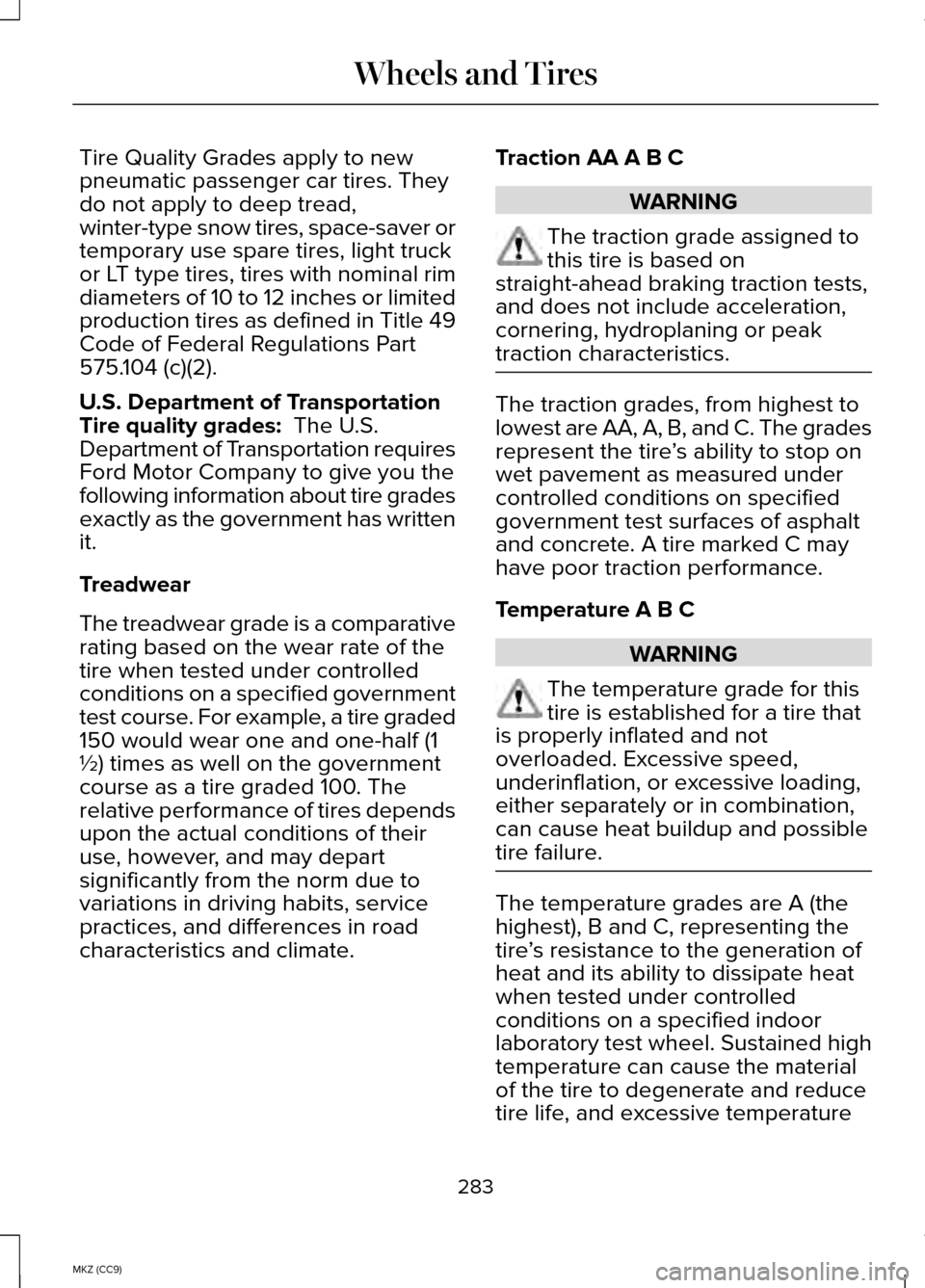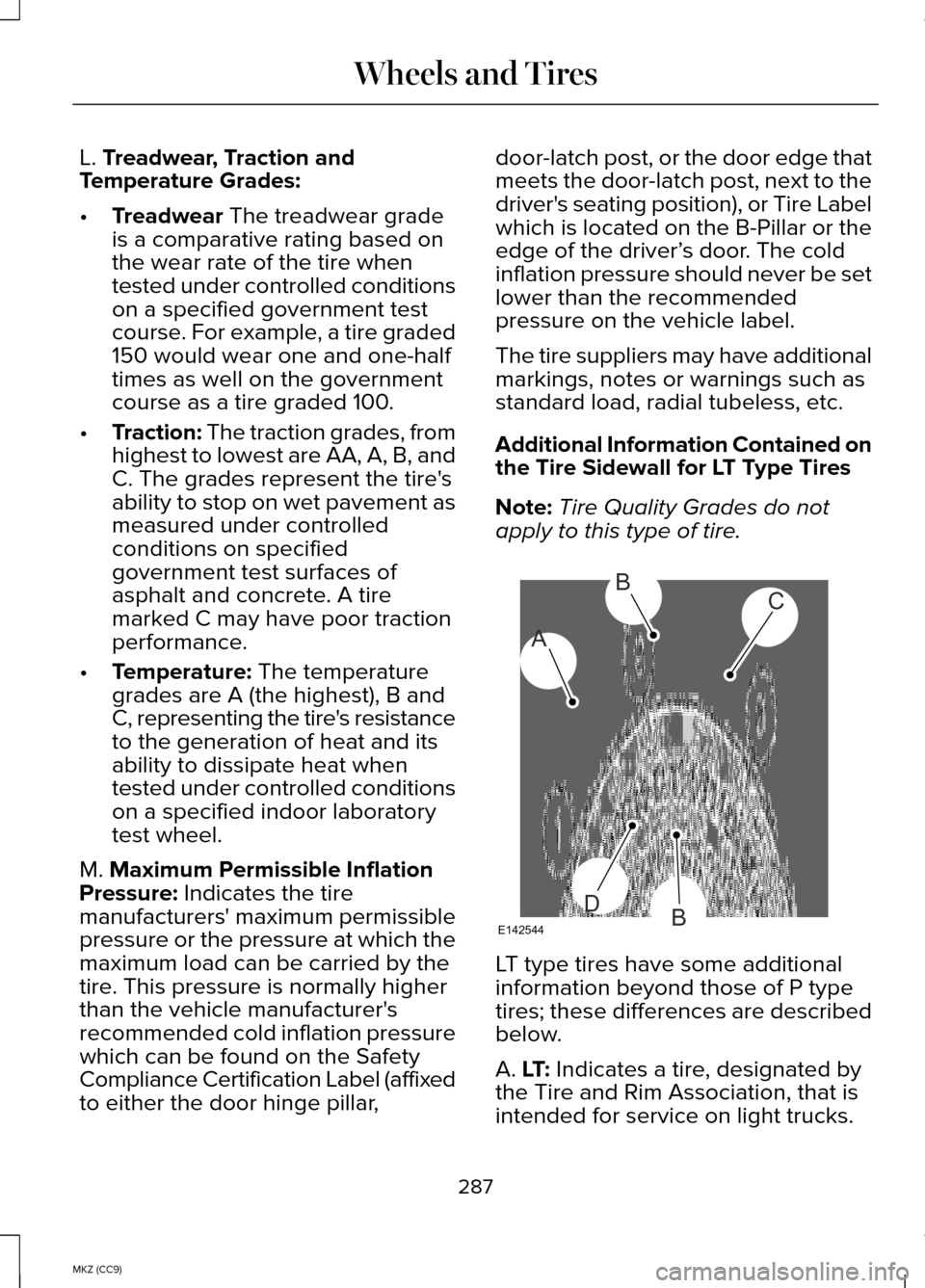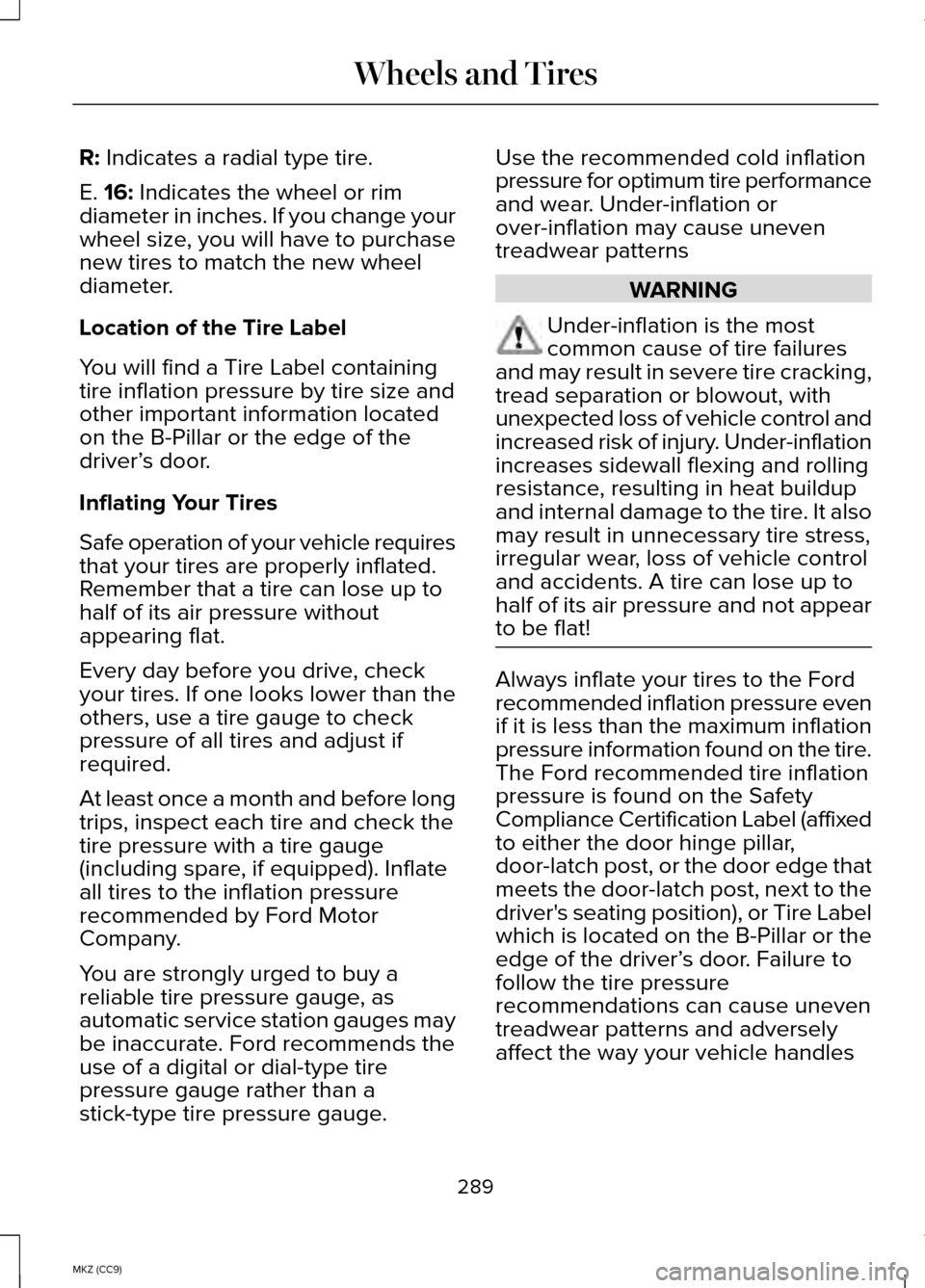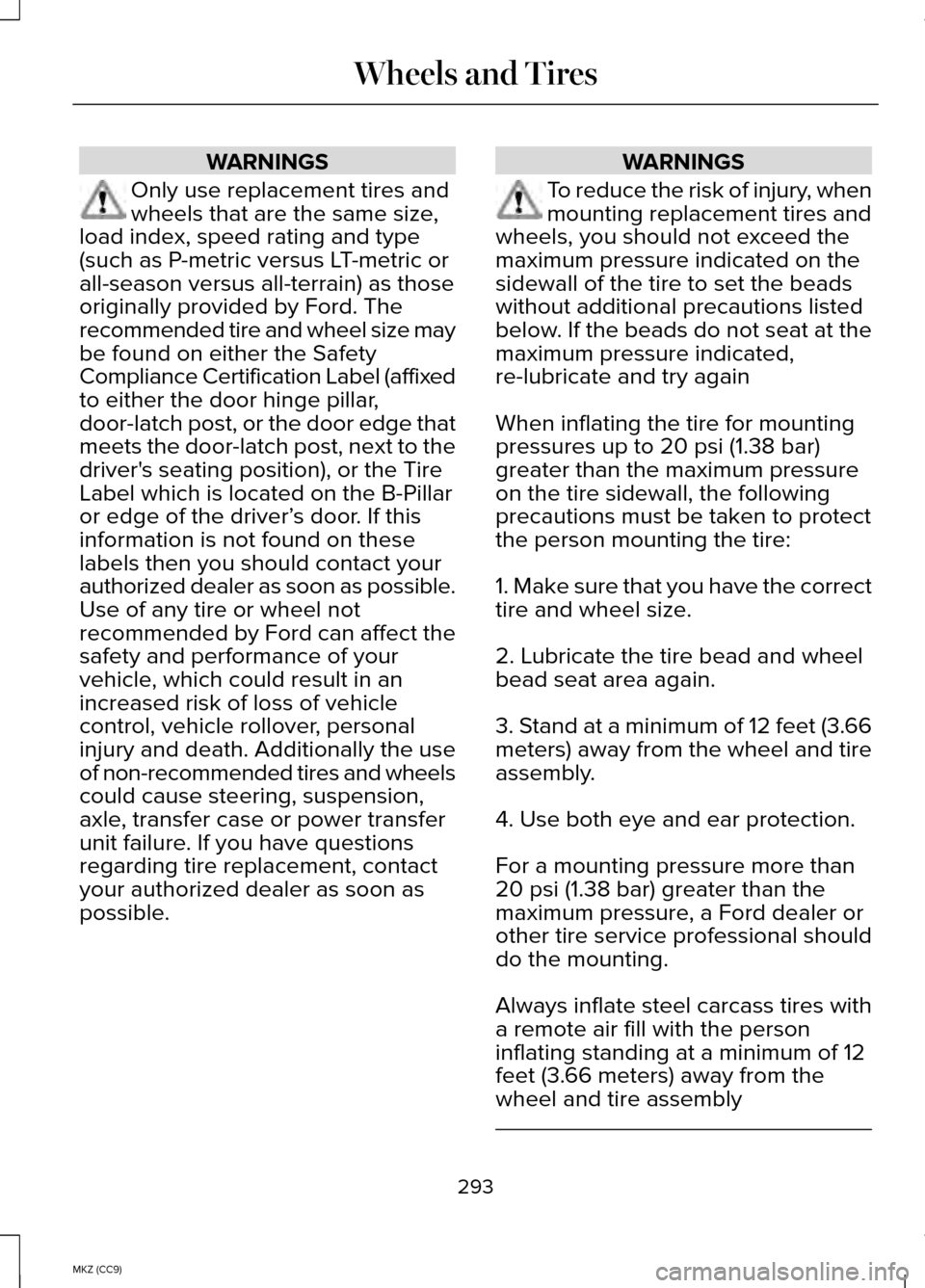2014 LINCOLN MKZ HYBRID service
[x] Cancel search: servicePage 285 of 445

Tire Quality Grades apply to new
pneumatic passenger car tires. They
do not apply to deep tread,
winter-type snow tires, space-saver or
temporary use spare tires, light truck
or LT type tires, tires with nominal rim
diameters of 10 to 12 inches or limited
production tires as defined in Title 49
Code of Federal Regulations Part
575.104 (c)(2).
U.S. Department of Transportation
Tire quality grades: The U.S.
Department of Transportation requires
Ford Motor Company to give you the
following information about tire grades
exactly as the government has written
it.
Treadwear
The treadwear grade is a comparative
rating based on the wear rate of the
tire when tested under controlled
conditions on a specified government
test course. For example, a tire graded
150 would wear one and one-half (1
½) times as well on the government
course as a tire graded 100. The
relative performance of tires depends
upon the actual conditions of their
use, however, and may depart
significantly from the norm due to
variations in driving habits, service
practices, and differences in road
characteristics and climate. Traction AA A B C WARNING
The traction grade assigned to
this tire is based on
straight-ahead braking traction tests,
and does not include acceleration,
cornering, hydroplaning or peak
traction characteristics. The traction grades, from highest to
lowest are AA, A, B, and C. The grades
represent the tire
’s ability to stop on
wet pavement as measured under
controlled conditions on specified
government test surfaces of asphalt
and concrete. A tire marked C may
have poor traction performance.
Temperature A B C WARNING
The temperature grade for this
tire is established for a tire that
is properly inflated and not
overloaded. Excessive speed,
underinflation, or excessive loading,
either separately or in combination,
can cause heat buildup and possible
tire failure. The temperature grades are A (the
highest), B and C, representing the
tire
’s resistance to the generation of
heat and its ability to dissipate heat
when tested under controlled
conditions on a specified indoor
laboratory test wheel. Sustained high
temperature can cause the material
of the tire to degenerate and reduce
tire life, and excessive temperature
283
MKZ (CC9) Wheels and Tires
Page 287 of 445

Information Contained on the Tire
Sidewall
Both U.S. and Canada Federal
regulations require tire manufacturers
to place standardized information on
the sidewall of all tires. This
information identifies and describes
the fundamental characteristics of the
tire and also provides a U.S. DOT Tire
Identification Number for safety
standard certification and in case of a
recall.
Information on P Type Tires
P215/65R15 95H is an example of a
tire size, load index and speed rating.
The definitions of these items are
listed below. (Note that the tire size,
load index and speed rating for your
vehicle may be different from this
example.) A. P: Indicates a tire, designated by
the Tire and Rim Association, that may
be used for service on cars, sport
utility vehicles, minivans and light
trucks. Note: If your tire size does not
begin with a letter this may mean it is
designated by either the European
Tire and Rim Technical Organization
or the Japan Tire Manufacturing
Association.
B.
215: Indicates the nominal width of
the tire in millimeters from sidewall
edge to sidewall edge. In general, the
larger the number, the wider the tire.
C. 65: Indicates the aspect ratio which
gives the tire's ratio of height to width.
D.
R: Indicates a radial type tire.
E.
15: Indicates the wheel or rim
diameter in inches. If you change your
wheel size, you will have to purchase
new tires to match the new wheel
diameter.
F.
95: Indicates the tire's load index.
It is an index that relates to how much
weight a tire can carry. You may find
this information in your owner’ s
manual. If not, contact a local tire
dealer.
Note: You may not find this
information on all tires because it is
not required by federal law.
G.
H: Indicates the tire's speed rating.
The speed rating denotes the speed
at which a tire is designed to be driven
for extended periods of time under a
standard condition of load and
inflation pressure. The tires on your
vehicle may operate at different
285
MKZ (CC9) Wheels and TiresH
I
J
KL
M
A
B
CDEFG
E142543
Page 289 of 445

L. Treadwear, Traction and
Temperature Grades:
• Treadwear
The treadwear grade
is a comparative rating based on
the wear rate of the tire when
tested under controlled conditions
on a specified government test
course. For example, a tire graded
150 would wear one and one-half
times as well on the government
course as a tire graded 100.
• Traction: The traction grades, from
highest to lowest are AA, A, B, and
C. The grades represent the tire's
ability to stop on wet pavement as
measured under controlled
conditions on specified
government test surfaces of
asphalt and concrete. A tire
marked C may have poor traction
performance.
• Temperature:
The temperature
grades are A (the highest), B and
C, representing the tire's resistance
to the generation of heat and its
ability to dissipate heat when
tested under controlled conditions
on a specified indoor laboratory
test wheel.
M.
Maximum Permissible Inflation
Pressure: Indicates the tire
manufacturers' maximum permissible
pressure or the pressure at which the
maximum load can be carried by the
tire. This pressure is normally higher
than the vehicle manufacturer's
recommended cold inflation pressure
which can be found on the Safety
Compliance Certification Label (affixed
to either the door hinge pillar, door-latch post, or the door edge that
meets the door-latch post, next to the
driver's seating position), or Tire Label
which is located on the B-Pillar or the
edge of the driver’
s door. The cold
inflation pressure should never be set
lower than the recommended
pressure on the vehicle label.
The tire suppliers may have additional
markings, notes or warnings such as
standard load, radial tubeless, etc.
Additional Information Contained on
the Tire Sidewall for LT Type Tires
Note: Tire Quality Grades do not
apply to this type of tire. LT type tires have some additional
information beyond those of P type
tires; these differences are described
below.
A.
LT: Indicates a tire, designated by
the Tire and Rim Association, that is
intended for service on light trucks.
287
MKZ (CC9) Wheels and TiresA
BC
BDE142544
Page 290 of 445

B. Load Range and Load Inflation
Limits: Indicates the tire's
load-carrying capabilities and its
inflation limits.
C. Maximum Load Dual lb (kg) at psi
(kPa) cold:
Indicates the maximum
load and tire pressure when the tire
is used as a dual; defined as four tires
on the rear axle (a total of six or more
tires on the vehicle).
D.
Maximum Load Single lb (kg) at
psi (kPa) cold: Indicates the maximum
load and tire pressure when the tire
is used as a single; defined as two
tires (total) on the rear axle.
Information on T Type Tires
T145/80D16 is an example of a tire
size.
Note: The temporary tire size for your
vehicle may be different from this
example. Tire Quality Grades do not
apply to this type of tire. T type tires have some additional
information beyond those of P type
tires; these differences are described
below:
A.
T: Indicates a type of tire,
designated by the Tire and Rim
Association, that is intended for
temporary service on cars, sport utility
vehicles, minivans and light trucks.
B.
145: Indicates the nominal width of
the tire in millimeters from sidewall
edge to sidewall edge. In general, the
larger the number, the wider the tire.
C. 80: Indicates the aspect ratio which
gives the tire's ratio of height to width.
Numbers of 70 or lower indicate a
short sidewall.
D.
D: Indicates a diagonal type tire.
288
MKZ (CC9) Wheels and TiresA
BCDE
E142545
Page 291 of 445

R: Indicates a radial type tire.
E.
16: Indicates the wheel or rim
diameter in inches. If you change your
wheel size, you will have to purchase
new tires to match the new wheel
diameter.
Location of the Tire Label
You will find a Tire Label containing
tire inflation pressure by tire size and
other important information located
on the B-Pillar or the edge of the
driver’ s door.
Inflating Your Tires
Safe operation of your vehicle requires
that your tires are properly inflated.
Remember that a tire can lose up to
half of its air pressure without
appearing flat.
Every day before you drive, check
your tires. If one looks lower than the
others, use a tire gauge to check
pressure of all tires and adjust if
required.
At least once a month and before long
trips, inspect each tire and check the
tire pressure with a tire gauge
(including spare, if equipped). Inflate
all tires to the inflation pressure
recommended by Ford Motor
Company.
You are strongly urged to buy a
reliable tire pressure gauge, as
automatic service station gauges may
be inaccurate. Ford recommends the
use of a digital or dial-type tire
pressure gauge rather than a
stick-type tire pressure gauge. Use the recommended cold inflation
pressure for optimum tire performance
and wear. Under-inflation or
over-inflation may cause uneven
treadwear patterns
WARNING
Under-inflation is the most
common cause of tire failures
and may result in severe tire cracking,
tread separation or blowout, with
unexpected loss of vehicle control and
increased risk of injury. Under-inflation
increases sidewall flexing and rolling
resistance, resulting in heat buildup
and internal damage to the tire. It also
may result in unnecessary tire stress,
irregular wear, loss of vehicle control
and accidents. A tire can lose up to
half of its air pressure and not appear
to be flat! Always inflate your tires to the Ford
recommended inflation pressure even
if it is less than the maximum inflation
pressure information found on the tire.
The Ford recommended tire inflation
pressure is found on the Safety
Compliance Certification Label (affixed
to either the door hinge pillar,
door-latch post, or the door edge that
meets the door-latch post, next to the
driver's seating position), or Tire Label
which is located on the B-Pillar or the
edge of the driver’
s door. Failure to
follow the tire pressure
recommendations can cause uneven
treadwear patterns and adversely
affect the way your vehicle handles
289
MKZ (CC9) Wheels and Tires
Page 295 of 445

WARNINGS
Only use replacement tires and
wheels that are the same size,
load index, speed rating and type
(such as P-metric versus LT-metric or
all-season versus all-terrain) as those
originally provided by Ford. The
recommended tire and wheel size may
be found on either the Safety
Compliance Certification Label (affixed
to either the door hinge pillar,
door-latch post, or the door edge that
meets the door-latch post, next to the
driver's seating position), or the Tire
Label which is located on the B-Pillar
or edge of the driver’ s door. If this
information is not found on these
labels then you should contact your
authorized dealer as soon as possible.
Use of any tire or wheel not
recommended by Ford can affect the
safety and performance of your
vehicle, which could result in an
increased risk of loss of vehicle
control, vehicle rollover, personal
injury and death. Additionally the use
of non-recommended tires and wheels
could cause steering, suspension,
axle, transfer case or power transfer
unit failure. If you have questions
regarding tire replacement, contact
your authorized dealer as soon as
possible. WARNINGS
To reduce the risk of injury, when
mounting replacement tires and
wheels, you should not exceed the
maximum pressure indicated on the
sidewall of the tire to set the beads
without additional precautions listed
below. If the beads do not seat at the
maximum pressure indicated,
re-lubricate and try again
When inflating the tire for mounting
pressures up to 20 psi (1.38 bar)
greater than the maximum pressure
on the tire sidewall, the following
precautions must be taken to protect
the person mounting the tire:
1. Make sure that you have the correct
tire and wheel size.
2. Lubricate the tire bead and wheel
bead seat area again.
3. Stand at a minimum of 12 feet (3.66
meters) away from the wheel and tire
assembly.
4. Use both eye and ear protection.
For a mounting pressure more than
20 psi (1.38 bar) greater than the
maximum pressure, a Ford dealer or
other tire service professional should
do the mounting.
Always inflate steel carcass tires with
a remote air fill with the person
inflating standing at a minimum of 12
feet (3.66 meters) away from the
wheel and tire assembly 293
MKZ (CC9) Wheels and Tires
Page 299 of 445

As an added safety feature, your vehicle
has been equipped with a tire pressure
monitoring system (TPMS) that illuminates
a low tire pressure telltale when one or
more of your tires is significantly
under-inflated. Accordingly, when the low
tire pressure telltale illuminates, you
should stop and check your tires as soon
as possible, and inflate them to the proper
pressure. Driving on a significantly
under-inflated tire causes the tire to
overheat and can lead to tire failure.
Under-inflation also reduces fuel efficiency
and tire tread life, and may affect the
vehicle
’s handling and stopping ability.
Please note that the TPMS is not a
substitute for proper tire maintenance, and
it is the driver’ s responsibility to maintain
correct tire pressure, even if under-inflation
has not reached the level to trigger
illumination of the TPMS low tire pressure
telltale.
Your vehicle has also been equipped with
a TPMS malfunction indicator to indicate
when the system is not operating properly.
The malfunction indicator is combined with
the low tire pressure telltale. When the
system detects a malfunction, the telltale
will flash for approximately one minute and
then remain continuously illuminated. This
sequence will continue upon subsequent
vehicle start-ups as long as the
malfunction exists.
When the malfunction indicator is
illuminated, the system may not be able
to detect or signal low tire pressure as
intended. TPMS malfunctions may occur
for a variety of reasons, including the
installation of replacement or alternate
tires or wheels on the vehicle that prevent
the TPMS from functioning properly. Always check the TPMS malfunction
telltale after replacing one or more tires
or wheels on your vehicle to ensure that
the replacement or alternate tires and
wheels allow the TPMS to continue to
function properly.
The tire pressure monitoring system
complies with part 15 of the FCC rules and
with RSS-210 of Industry Canada.
Operation is subject to the following two
conditions: (1) This device may not cause
harmful interference, and (2) This device
must accept any interference received,
including interference that may cause
undesired operation.
Changing Tires with a Tire Pressure
Monitoring System
Note:
Each road tire is equipped with a
tire pressure sensor located inside the
wheel and tire assembly cavity. The
pressure sensor is attached to the valve
stem. The pressure sensor is covered by
the tire and is not visible unless the tire is
removed. Care must be taken when
changing the tire to avoid damaging the
sensor
It is recommended that you always have
your tires serviced by an authorized
dealer.
297
MKZ (CC9) Wheels and TiresE142549
Page 310 of 445

Ford part number / Ford
specification
Ford part name or
equivalent
Capacity
Item
/WSS-M2C31-B2
1 Ford recommends using Motorcraft (Ford) DOT 4 LV High Performance Motor Vehicle
Brake Fluid or equivalent meeting WSS-M6C65-A2. Use of any fluid other than \
the
recommended fluid may cause degraded brake performance and not meet the Ford
performance standards. Keep brake fluid clean and dry. Contamination with dirt, water,
petroleum products or other materials may result in brake system damage and possible
failure.
2 Approximate dry fill capacity. Actual amount may vary during fluid changes.
3 Automatic transmissions that require Motorcraft MERCON LV transmission fluid should
only use Motorcraft MERCON LV transmission fluid.
Use of any fluid other than the recommended fluid may cause transmission\
damage.
Change the automatic transmission fluid and filter at the correct servic\
e interval. See
Scheduled Maintenance (page 412).
4 The design of your engine allows for the use of Motorcraft engine oils o\
r equivalent oils
that meet Ford specifications. It is also acceptable to use an engine oi\
l of recommended
viscosity grade that meets API SN requirements and displays the API cert\
ification mark
for gasoline engines.
5 Do not use supplemental engine oil additives, cleaners or other engine t\
reatments. They
are unnecessary and could lead to engine damage not covered by Ford warr\
anty.
6 Do not use API S category oils labeled as SN, SM, SL or lower category u\
nless the label
also displays the API certification mark. These oils do not meet the req\
uirements of the
engine and emission system.
7 You can use 5W-20 oil if 0W-20 oil is not available.
8 Add the coolant type originally equipped in your vehicle.
9 See the warning below: WARNING
The air conditioning refrigerant system contains refrigerant R-134a unde\
r high
pressure. Opening the air conditioning refrigerant system can cause personal inj\
ury.
Have the air conditioning refrigerant system serviced only by qualified \
personnel. 308
MKZ (CC9) Capacities and Specifications